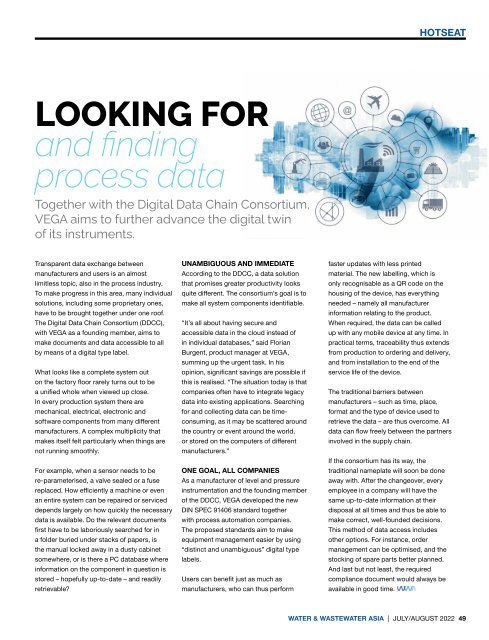Water & Wastewater Asia July/August 2022
Water & Wastewater Asia is an expert source of industry information, cementing its position as an indispensable tool for trade professionals in the water and wastewater industry. As the most reliable publication in the region, industry experts turn this premium journal for credible journalism and exclusive insight provided by fellow industry professionals. Water & Wastewater Asia incorporates the official newsletter of the Singapore Water Association (SWA)
Water & Wastewater Asia is an expert source of industry information, cementing its position as an indispensable tool for trade professionals in the water and wastewater industry. As the most reliable publication in the region, industry experts turn this premium journal for credible journalism and exclusive insight provided by fellow industry professionals. Water & Wastewater Asia incorporates the official newsletter of the Singapore Water Association (SWA)
You also want an ePaper? Increase the reach of your titles
YUMPU automatically turns print PDFs into web optimized ePapers that Google loves.
HOTSEAT<br />
LOOKING FOR<br />
and finding<br />
process data<br />
Together with the Digital Data Chain Consortium,<br />
VEGA aims to further advance the digital twin<br />
of its instruments.<br />
Transparent data exchange between<br />
manufacturers and users is an almost<br />
limitless topic, also in the process industry.<br />
To make progress in this area, many individual<br />
solutions, including some proprietary ones,<br />
have to be brought together under one roof.<br />
The Digital Data Chain Consortium (DDCC),<br />
with VEGA as a founding member, aims to<br />
make documents and data accessible to all<br />
by means of a digital type label.<br />
What looks like a complete system out<br />
on the factory floor rarely turns out to be<br />
a unified whole when viewed up close.<br />
In every production system there are<br />
mechanical, electrical, electronic and<br />
software components from many different<br />
manufacturers. A complex multiplicity that<br />
makes itself felt particularly when things are<br />
not running smoothly.<br />
For example, when a sensor needs to be<br />
re-parameterised, a valve sealed or a fuse<br />
replaced. How efficiently a machine or even<br />
an entire system can be repaired or serviced<br />
depends largely on how quickly the necessary<br />
data is available. Do the relevant documents<br />
first have to be laboriously searched for in<br />
a folder buried under stacks of papers, is<br />
the manual locked away in a dusty cabinet<br />
somewhere, or is there a PC database where<br />
information on the component in question is<br />
stored – hopefully up-to-date – and readily<br />
retrievable?<br />
UNAMBIGUOUS AND IMMEDIATE<br />
According to the DDCC, a data solution<br />
that promises greater productivity looks<br />
quite different. The consortium’s goal is to<br />
make all system components identifiable.<br />
“It’s all about having secure and<br />
accessible data in the cloud instead of<br />
in individual databases,” said Florian<br />
Burgent, product manager at VEGA,<br />
summing up the urgent task. In his<br />
opinion, significant savings are possible if<br />
this is realised. “The situation today is that<br />
companies often have to integrate legacy<br />
data into existing applications. Searching<br />
for and collecting data can be timeconsuming,<br />
as it may be scattered around<br />
the country or event around the world,<br />
or stored on the computers of different<br />
manufacturers.”<br />
ONE GOAL, ALL COMPANIES<br />
As a manufacturer of level and pressure<br />
instrumentation and the founding member<br />
of the DDCC, VEGA developed the new<br />
DIN SPEC 91406 standard together<br />
with process automation companies.<br />
The proposed standards aim to make<br />
equipment management easier by using<br />
“distinct and unambiguous” digital type<br />
labels.<br />
Users can benefit just as much as<br />
manufacturers, who can thus perform<br />
faster updates with less printed<br />
material. The new labelling, which is<br />
only recognisable as a QR code on the<br />
housing of the device, has everything<br />
needed – namely all manufacturer<br />
information relating to the product.<br />
When required, the data can be called<br />
up with any mobile device at any time. In<br />
practical terms, traceability thus extends<br />
from production to ordering and delivery,<br />
and from installation to the end of the<br />
service life of the device.<br />
The traditional barriers between<br />
manufacturers – such as time, place,<br />
format and the type of device used to<br />
retrieve the data – are thus overcome. All<br />
data can flow freely between the partners<br />
involved in the supply chain.<br />
If the consortium has its way, the<br />
traditional nameplate will soon be done<br />
away with. After the changeover, every<br />
employee in a company will have the<br />
same up-to-date information at their<br />
disposal at all times and thus be able to<br />
make correct, well-founded decisions.<br />
This method of data access includes<br />
other options. For instance, order<br />
management can be optimised, and the<br />
stocking of spare parts better planned.<br />
And last but not least, the required<br />
compliance document would always be<br />
available in good time.<br />
WATER & WASTEWATER ASIA | JULY/AUGUST <strong>2022</strong> 49


















